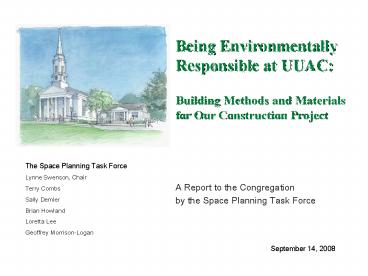Being Environmentally Responsible at UUAC: - PowerPoint PPT Presentation
1 / 16
Title:
Being Environmentally Responsible at UUAC:
Description:
Geoffrey Morrison-Logan. Being Environmentally Responsible at UUAC: ... Conducted a survey to understand our space needs. Contracted with Adams and Smith, Architects ... – PowerPoint PPT presentation
Number of Views:23
Avg rating:3.0/5.0
Title: Being Environmentally Responsible at UUAC:
1
- Being Environmentally Responsible at UUAC
- Building Methods and Materialsfor Our
Construction Project - A Report to the Congregation
- by the Space Planning Task Force
The Space Planning Task Force Lynne Swenson,
Chair Terry Combs Sally Demler Brian
Howland Loretta Lee Geoffrey Morrison-Logan
September 14, 2008
2
Agenda
- A little background
- Our Goals
- Green practices that we can implement
- Questions and Answers
3
Our Process
- Together we have
- Conducted a survey to understand our space needs
- Contracted with Adams and Smith, Architects
- Developed a plan for our new construction
- Launched a Capital Campaign.
- Now it is time to plan a building that meets our
needs AND is environmentally responsible.
4
Building Project Goals
- We are learning how we can
- Use environmentally responsible building
practices and materials wherever possible. - Plan for future green improvements not
currently in the budget. - We will be recommending upgrades to the
present building that will make it more energy
efficient.
5
The greenest thing we can do is design the
smallest building that meets our needs.
- Our new construction will create enough room for
our needs with the least amount of additional
space. - Our new construction will be more efficient than
our existing space, and will be less costly to
maintain. - We will use as many recycled resources as
possible to create the new space.
6
How to build GREEN
- Options we can do now
- Insulate with recycled materials
- Insulate with highly energy-efficient materials
- Install programmable thermostats
- Use low VOC (volatile organic compounds)
paints and carpeting - Options to prepare for now and add later
- Photovoltaic solar cells or panels
5
7
What About Our Existing Building?
- This presentation addresses recommendations for
the new construction, plus some recommendations
for making our existing structures more
efficient. - The Space Planning Task Force will offer the
Building and Grounds Committee ideas and
recommendations for increasing the energy
efficiency of our Sanctuary and the Unity Hall
Building.
8
How green are our present buildings?
Not very. We have an opportunity to improve the
efficiency of the current structures (Sanctuary
and Unity Hall Building) as we build green for
the new addition. Just meeting the existing
building code requirements in our new
construction will lead to much greater efficiency
than was achieved in 1964. Or 1830.
9
Six Areas with a BIG Impact
- Brian and Terry will discuss
- Sealing the envelope insulation
- Green heating, ventilation, and air
conditioning (HVAC) - Green plumbing
- Green lighting
- Green paints and carpets
- Green landscaping.
10
Sealing the Envelope Insulation choices are
opportunities for increased energy efficiency
- Using environmentally friendly insulation is a
cost-effective method for increasing energy
efficiency. - We recommend using insulation that is above code.
Some environmentally friendly options include - Icynene open-cell foam spray
- Closed-cell polyurethane
- Wet cellulose
- Eco-friendly fiberglass
- Cotton or wool fiber.
11
Green Heating, Ventilation, and Air Conditioning
(HVAC) Considerations
- Practical options
- Programmable thermostats. We will implement
- these in the new construction, and replace
existing - thermostats in the Sanctuary and Unity Hall
Building. - Zoned heat controls will be implemented in the
new construction.
12
Green Plumbing Considerations
- Low-flow fixtures will be installed in the new
bathrooms. - Energy-efficient appliances are recommended for
the kitchen, including an energy-efficient - refrigerator
- dishwasher.
13
Green Lighting Considerations
- State-of-the-art lighting controls will be
implemented in the new construction, and
retrofitted (where they arent already) to
our existing structures. - Low wattage lighting will be implemented in the
new construction. - Photo-voltaic cells. We are investigating
obtaining grants for installing photo-voltaic
cells on the roof as a source of electricity.
14
Green paints and carpets
- We have many options
- Low VOC paints and carpeting
- Recycled carpeting
- Cork
- Recycled vinyl carpeting
- Rubber flooring
15
Green landscaping considerations
- Grass turf pavers allow grass to grow through
paving material. (This is already in the
plans.) - Permeable pavers are another paving option.
- Locally sourced wood, stone, and other materials
will be used where possible.
16
In conclusion
- We have reviewed many green building options
- We appreciate your ideas and feedback
- We will be working with the architects and the
builders to implement these options during the
construction planning phase































